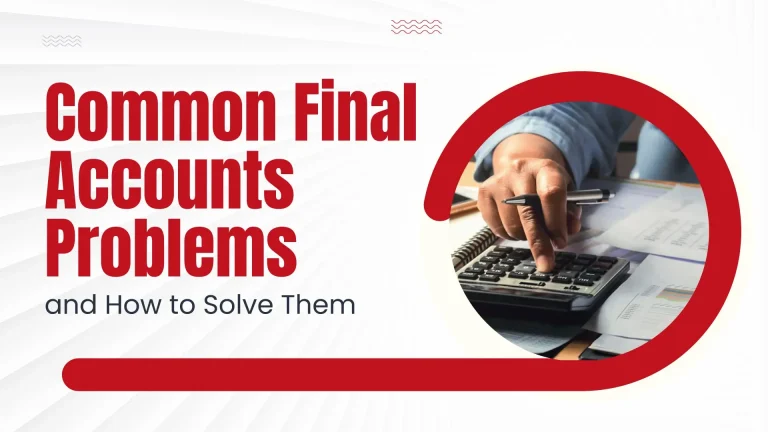Managing final accounts is a critical aspect of any business’s financial health. Final accounts include the trading account, profit and loss account, and the balance sheet. These accounts provide a comprehensive view of the financial performance and position of a business. However, several common final accounts problems can arise when preparing these accounts. Understanding these issues and knowing how to solve them is crucial for maintaining accurate financial records and ensuring regulatory compliance. In this blog, we will explore the most common final accounts problems and provide practical solutions to address them. This guide aims to help you navigate the complexities of final accounts with ease.
Understanding Final Accounts
Final accounts summarize the financial activities of a business at the end of an accounting period. They typically include:
- Trading Account: Shows the gross profit or loss of the business.
- Profit and Loss Account: Details the net profit or loss by accounting for all expenses and incomes.
- Balance Sheet: Reflects the financial position of the business, showing assets, liabilities, and equity.
Now, let’s examine the common problems associated with final accounts.
Final Accounts Problems
Problem 1: Inaccurate Data Entry
One of the most frequent issues in preparing final accounts is inaccurate data entry. Even a small error in data entry can lead to significant discrepancies in financial statements. This problem can arise due to manual entry errors, misunderstanding of financial data, or miscommunication between departments.
Solution:
- Implement Double-Entry System: Using a double-entry accounting system helps in cross-verifying entries and reducing errors.
- Regular Audits: Conduct regular audits to detect and correct errors promptly.
- Training and Education: Ensure that staff involved in data entry are well-trained in accounting principles and software.
Problem 2: Misclassification of Transactions
Misclassification of transactions is another common problem. This occurs when expenses, revenues, assets, or liabilities are incorrectly categorized, leading to inaccurate financial statements.
Solution:
- Clear Accounting Policies: Establish clear guidelines and policies for classifying transactions.
- Use Accounting Software: Modern accounting software often includes features that help prevent misclassification.
- Periodic Reviews: Regularly review transaction classifications to ensure they align with established guidelines.
Problem 3: Incomplete Records
Incomplete records can result from missing invoices, unrecorded transactions, or lost receipts. This issue can severely impact the accuracy of the final accounts.
Solution:
- Document Management System: Implement a robust document management system to organize and store financial documents.
- Regular Reconciliation: Perform regular reconciliation of accounts to ensure all transactions are recorded.
- Backup Procedures: Establish backup procedures to safeguard against loss of financial records.
Problem 4: Incorrect Calculations
Errors in calculations can occur due to manual computation mistakes or incorrect formulae in spreadsheets. These errors can distort the financial picture of the business.
Solution:
- Automated Tools: Utilize accounting software that automates calculations to minimize errors.
- Review and Check: Always review and double-check calculations, especially for critical figures.
- Standardized Templates: Use standardized templates for financial statements to ensure consistency and accuracy.
Problem 5: Timing Issues
Timing issues arise when transactions are recorded in the wrong accounting period. This can affect the accuracy of financial reports and lead to non-compliance with accounting standards.
Solution:
- Accrual Accounting: Adopt accrual accounting principles to match revenues and expenses to the correct period.
- Cut-off Procedures: Establish clear cut-off procedures for recording transactions at the end of the accounting period.
- Regular Monitoring: Monitor transactions regularly to ensure they are recorded in the correct period.
Problem 6: Lack of Reconciliation
Failing to reconcile accounts regularly can result in discrepancies between the general ledger and subsidiary ledgers. This problem can lead to inaccurate financial statements.
Solution:
- Monthly Reconciliation: Perform monthly reconciliations of all major accounts, including bank accounts, receivables, and payables.
- Automated Reconciliation Tools: Use automated tools that can simplify and expedite the reconciliation process.
- Exception Reports: Generate exception reports to identify and resolve discrepancies promptly.
Problem 7: Inadequate Internal Controls
Inadequate internal controls can lead to errors and fraud, impacting the reliability of final accounts. This issue can arise from a lack of segregation of duties, insufficient oversight, or weak security measures.
Solution:
- Strengthen Internal Controls: Implement robust internal controls, including segregation of duties and authorization procedures.
- Regular Audits: Conduct regular internal and external audits to ensure compliance with internal controls.
- Employee Training: Train employees on the importance of internal controls and how to adhere to them.
Problem 8: Inconsistent Application of Accounting Policies
Inconsistent application of accounting policies can lead to variations in financial reporting, making it difficult to compare financial statements over different periods.
Solution:
- Standardized Policies: Develop and implement standardized accounting policies and procedures.
- Consistency Checks: Regularly review financial statements to ensure consistency in the application of accounting policies.
- Training Programs: Conduct training programs for accounting staff to ensure they understand and apply policies consistently.
Problem 9: Overlooking Adjustments and Accruals
Adjustments and accruals are essential for accurate financial reporting. Overlooking these can result in financial statements that do not reflect the true financial position of the business.
Solution:
- Regular Adjustments: Make regular adjustments for accrued expenses, prepaid expenses, and other necessary items.
- Use Accounting Software: Utilize accounting software to automate and track adjustments and accruals.
- Review Processes: Establish a review process to ensure all necessary adjustments are made before finalizing accounts.
Problem 10: Non-Compliance with Accounting Standards
Non-compliance with accounting standards can result in inaccurate financial reporting and potential legal issues. This problem can occur due to a lack of knowledge or understanding of relevant standards.
Solution:
- Stay Updated: Keep up-to-date with changes in accounting standards and regulations.
- Professional Development: Invest in continuous professional development for accounting staff.
- Consult Experts: Seek advice from accounting professionals or consultants to ensure compliance with standards.
Problem 11: Lack of Understanding of Financial Reports
Sometimes, those responsible for preparing or analyzing final accounts may not fully understand the financial reports. This lack of understanding can lead to misinterpretation of data and poor decision-making.
Solution:
- Training and Education: Provide comprehensive training to staff on how to read and interpret financial reports.
- Use Simple Language: Present financial information in simple, clear language to make it more accessible.
- Seek Professional Advice: Consult with financial experts to gain a better understanding of complex reports.
Problem 12: Inefficient Use of Accounting Software
Even when businesses have accounting software, they may not use it to its full potential. This can result in missed opportunities for improving accuracy and efficiency in preparing final accounts.
Solution:
- Proper Training: Ensure that all users of the accounting software receive proper training.
- Utilize All Features: Make full use of the features offered by the accounting software to streamline accounting processes.
- Regular Updates: Keep the software updated to benefit from the latest improvements and features.
Problem 13: Difficulty in Consolidating Accounts
For businesses with multiple branches or subsidiaries, consolidating accounts can be a challenging task. This complexity can lead to errors and delays in preparing final accounts.
Solution:
- Standardized Procedures: Implement standardized procedures for consolidating accounts across different branches or subsidiaries.
- Use Consolidation Software: Utilize software designed specifically for consolidating accounts.
- Regular Coordination: Ensure regular communication and coordination between the finance teams of different branches or subsidiaries.
Problem 14: Ineffective Communication Between Departments
Lack of effective communication between departments can result in incomplete or inaccurate financial data. This problem often arises in larger organizations with multiple departments handling different aspects of accounting.
Solution:
- Clear Communication Channels: Establish clear communication channels between departments.
- Regular Meetings: Hold regular meetings to ensure all departments are aligned and aware of their responsibilities.
- Integrated Systems: Use integrated accounting systems that facilitate seamless data sharing between departments.
Conclusion
Final accounts are a vital component of any business’s financial management. However, preparing these accounts is fraught with challenges. By understanding the common problems and implementing the solutions discussed above, businesses can improve the accuracy and reliability of their financial statements. Regular training, use of modern accounting software, and adherence to standardized policies can go a long way in preventing and resolving issues related to final accounts. Ensuring accurate final accounts not only helps in regulatory compliance but also provides a clear picture of the financial health of the business, aiding in better decision-making and strategic planning.
Also Read:
- What Should You Look for in Accounting Programs for Small Business?Depending on a good selection of Accounting Programs for Small Business, you can succeed or not. The small business owners can easily keep a record of expenditure, automate their bills, and remain compliant with appropriate tools. Nevertheless, not every accounting… Read more: What Should You Look for in Accounting Programs for Small Business?
- How Do Accounting Platforms Improve Financial Accuracy in 2025?The financial accuracy is more than just a buzzword – it’s the backbone of smart decision-making. As we step further into 2025, businesses are no longer relying solely on manual bookkeeping or outdated systems. Instead, they’re embracing modern accounting platforms… Read more: How Do Accounting Platforms Improve Financial Accuracy in 2025?
- Why Is It Important to Understand the Account Golden Rules with Example?When it comes to managing business finances in India, understanding the account golden rules with examples is essential, especially for startups, small business owners, and even freelancers. No matter how big or small your venture is, the fundamentals of accounting… Read more: Why Is It Important to Understand the Account Golden Rules with Example?
- Why Are the Accounting Three Golden Rules Still Relevant Today?The various accounting practices continue to play a crucial role in managing the financial health of organizations. Whether it’s a small startup or a multinational corporation, accurate financial reporting and decision-making are vital. While technology has drastically transformed accounting, some… Read more: Why Are the Accounting Three Golden Rules Still Relevant Today?
Frequently Asked Questions
What are common final accounts problems businesses face?
Common final accounts problems include inaccurate data entry, misclassification of transactions, incomplete records, incorrect calculations, timing issues, lack of regular reconciliation, inadequate internal controls, inconsistent application of accounting policies, overlooking adjustments and accruals, and non-compliance with accounting standards. Each of these issues can lead to inaccurate financial statements, making it difficult to gauge the true financial health of the business. Addressing these problems requires a combination of good practices, proper training, and the use of modern accounting tools.
How can I avoid inaccurate data entry in final accounts?
To avoid inaccurate data entry, implement a double-entry accounting system, which helps in cross-verifying entries and reducing errors. Conduct regular audits to detect and correct errors promptly. Ensure that staff involved in data entry are well-trained in accounting principles and software. Use accounting software that can minimize manual entry errors. Regularly review and validate the entered data to catch and correct mistakes early. This proactive approach will help in maintaining accurate records.
Why do transactions get misclassified, and how to prevent it?
Transactions get misclassified due to a lack of understanding of accounting categories or careless mistakes. To prevent this, establish clear guidelines and policies for classifying transactions. Use accounting software that has built-in features to reduce misclassification. Regularly review and update these classifications to ensure they are correct. Training staff on the proper categorization of transactions is also essential. Consistent monitoring and review of the transactions can help in catching and correcting misclassifications early.
What causes incomplete records, and how to ensure completeness?
Incomplete records are often caused by missing invoices, unrecorded transactions, or lost receipts. To ensure completeness, implement a robust document management system to organize and store all financial documents. Perform regular reconciliation of accounts to ensure all transactions are recorded. Establish backup procedures to safeguard against the loss of financial records. Conduct regular checks and audits to verify that all records are complete and accurate. Using automated systems can also help in tracking and recording every transaction effectively.
How can businesses correct incorrect calculations in accounts?
To correct incorrect calculations, use accounting software that automates calculations, minimizing human error. Always review and double-check calculations, especially for critical figures. Standardize templates for financial statements to ensure consistency and accuracy. Train staff on the importance of verifying their work and provide them with tools to help identify and correct errors. Regularly review financial statements and perform cross-checks to ensure calculations are correct. This multi-step approach will help in maintaining accurate financial records.
What are timing issues in final accounts, and how to resolve them?
Timing issues occur when transactions are recorded in the wrong accounting period. To resolve this, adopt accrual accounting principles that match revenues and expenses to the correct period. Establish clear cut-off procedures for recording transactions at the end of the accounting period. Regularly monitor transactions to ensure they are recorded in the appropriate period. Conduct periodic reviews to catch any timing errors and correct them promptly. Ensuring proper timing of transactions is crucial for accurate financial reporting.
How often should accounts be reconciled to avoid discrepancies?
Accounts should be reconciled monthly to avoid discrepancies. Perform reconciliations for all major accounts, including bank accounts, receivables, and payables. Use automated reconciliation tools to simplify and expedite the process. Generate exception reports to identify and resolve discrepancies promptly. Regular reconciliation helps in maintaining accurate financial records and catching errors early. This practice also ensures that the financial statements reflect the true financial position of the business.
What are the risks of inadequate internal controls in final accounts?
Inadequate internal controls can lead to errors, fraud, and unreliable financial statements. This risk arises from a lack of segregation of duties, insufficient oversight, or weak security measures. To mitigate these risks, implement robust internal controls, including segregation of duties and authorization procedures. Conduct regular internal and external audits to ensure compliance with internal controls. Train employees on the importance of internal controls and how to adhere to them. Strong internal controls are essential for maintaining accurate and reliable financial records.
Why is consistent application of accounting policies important?
Consistent application of accounting policies ensures that financial statements are comparable over different periods. Inconsistent application can lead to variations in financial reporting, making it difficult to assess the business’s performance accurately. To maintain consistency, develop and implement standardized accounting policies and procedures. Regularly review financial statements to ensure policies are applied consistently. Conduct training programs for accounting staff to ensure they understand and apply policies correctly. Consistency in accounting practices enhances the reliability of financial reports.
How can businesses stay compliant with accounting standards?
To stay compliant with accounting standards, businesses should keep up-to-date with changes in accounting standards and regulations. Invest in continuous professional development for accounting staff. Seek advice from accounting professionals or consultants to ensure compliance with standards. Regularly review and update accounting policies and procedures to align with current standards. Conduct internal audits to check compliance and correct any deviations. Staying compliant with accounting standards is crucial for accurate financial reporting and avoiding legal issues.





